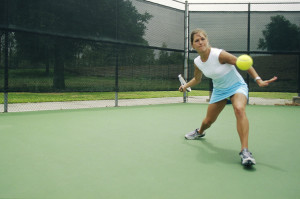4 Strategies For The Player Who Gets Tight
posted on: July 20, 2016
author: Brian Lomax, Ed.D.
 Have you ever felt tight or tense while competing? If you’re like most people, myself included, you have probably felt this way at some point in your competitive career. Sometimes it just happens under pressure and at other times, that tight and tense feeling is present from the beginning. Whatever the situation, it doesn’t feel good, and that tightness in our muscles prevents our best game from emerging.
Have you ever felt tight or tense while competing? If you’re like most people, myself included, you have probably felt this way at some point in your competitive career. Sometimes it just happens under pressure and at other times, that tight and tense feeling is present from the beginning. Whatever the situation, it doesn’t feel good, and that tightness in our muscles prevents our best game from emerging.
This topic has been coming up a lot lately with my students and it’s something I need to improve on myself. Tight and tense muscles can be a huge energy drain, and for us tennis players, we tend to hit the ball short in the court with limited power. We often play more conservatively and make errors into the net. Instead, we want to look like Roger Federer who appears loose, relaxed and floating around the court. Roger always goes for his shots and we need to do the same to be successful.
So what can we do about this? Here are a few points to consider in your competitive training.
1. Treat Relaxation as a Skill
We all know that we perform better when our muscles are loose, but we don’t all know how to reduce muscle tension at a given moment. We may not have that kind of awareness with our bodies, and therefore it’s necessary to view relaxation skills and exercises as an important part of your competitive skills training.
2. Train Relaxation off the Court
Like any skill, learning to relax and reduce muscle tension requires practice and patience. This article on Relaxation Techniques has some excellent suggestions for ways to practice and improve, and I especially like Progressive Relaxation as a technique because it helps you build awareness and communication with your muscles. Jeff Greenwald mentions this same technique in his book The Best Tennis of Your Life (Chapter 43) so that is another resource for your training. Additionally, consider adding some of the breathing exercises described in the article linked above. While the article is centered on the topic of “stress relief”, that’s not what we are trying to do. We aren’t relieving stress, we are training a productive reaction to stress that will allow us to handle it better.
Commit to practicing these techniques several days a week. As you do them, associate some “cue words” with these activities so that you can use these words on the court when you need them. For example, while you’re doing progressive relaxation, think “loose muscles.” You can then use “loose muscles” as a phrase to initiate your relaxation response while you’re playing.
3. Train Relaxation on the Court
When feeling tight on the court, there are several things you can do.
- Focus on your breath between points – use rhythmic breathing (consistent inhales and exhales) to slow your heart rate and clear your mind. This breathing technique will naturally relax you.
- Bounce up and down, and shake the tension out of your arms – do this before the start of every point. Doing it once or twice won’t have the desired effect. It needs to be done consistently for a sustained period of time.
- Use your cue words – as you are doing the above 2 techniques, repeat your cue words in your mind (“loose muscles”). This will help you to trigger the relaxation response you’ve been training off court.
- Progressive relaxation on change of sides – when you sit down for the change over, do some progressive relaxation for your hands, arms, and shoulders.
4. Keep a Training Log
Since relaxation and tension reduction are skills, you’re not necessarily going to be great at them right away. Use a training log to evaluate and monitor how you feel on and off the court. After a few weeks, compare how you feel today with how you felt during week 1 of your training. You should notice that you are getting better at inducing the relaxation response and that how you are playing in competition feels better.
So you may be thinking that training the relaxation response is a bit out there or over the top, but I believe that this is one of those “little things” that will add up to better performances on the court. Try the above for several weeks and see if you notice a difference (via your training log). These techniques don’t take huge amounts of time, and they will have a cumulative effect.
Let me know your thoughts in the comments!
About the Author
Dr. Brian Lomax founded PerformanceXtra™ in 2009 with a mission of helping athletes achieve their goals and their top performances more consistently through a progression of mental skills that enables them to focus on what is truly important.
Learn more about the author: https://performancextra.com/brian-lomax/
